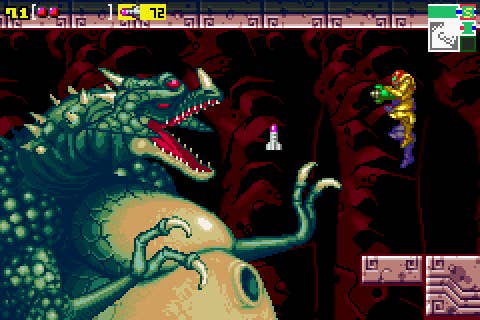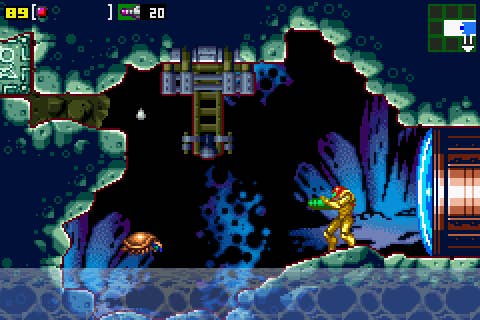Metroid Game By Game Reviews: Metroid Zero Mission
The golden standard of remakes.
This article first appeared on USgamer, a partner publication of VG247. Some content, such as this article, has been migrated to VG247 for posterity after USgamer's closure - but it has not been edited or further vetted by the VG247 team.
Early word on the street - including both Kat's and my own - says that Metroid: Samus Returns offers an excellent adaptation of the rockiest of old-school Metroid games, Metroid II. As a return to form for the series, I'm comfortable declaring it "mission accomplished." As a redemptive effort for co-developer MercurySteam after the frankly abysmal Castlevania: Lords of Shadow: Mirror of Fate, Samus Returns might prove to be an even greater success.
There's one other bar it needs to clear before we can go all-in on the Samus Returns hyperbole, however, and that's the "Metroid remake" bar. The trouble is, the standard for that category was set ridiculously high back in 2004 by Metroid: Zero Mission for Game Boy Advance.
At the time of its debut, Zero Mission redefined what players should expect from remakes of classic games. It was no mere facelift, though it certainly looked nice; Nintendo took the framework of the original Metroid for NES and rebuilt every inch of planet Zebes to conform to contemporary 2004 standards. Not only did Zero Mission hammer out all the design grievances of a game published early in the NES era - everything from restarting a new playthrough with only 30 points of health to the tedious vertical shafts scattered around the labyrinth - it added in a number of new features and ideas gathered from Super Metroid and Metroid Fusion.

The balancing act becomes all the more remarkable when you consider that Super Metroid had, in many ways, already taken a swing at redoing the original Metroid and connected with a home run. Yet despite literally covering much of the same ground as Super Metroid, Zero Mission feels wholly distinct, with no redundancy. What repetition you encounter here appears thematic rather than uninspired.
Crucially, Zero Mission manages to retain the exploratory spirit of the original Metroid. That's no small consideration given that it shared much of its development team with the didactic Metroid Fusion, a game that alienated many fans with its endless chatter and suffocating constraints. Fusion's dev staff had not, as some less charitable players speculated, forgotten how to make a good Metroid game. Rather, the entire of crux of Fusion hung on the premise of Samus having been greatly reduced in strength while being stalked by a shadow of her full-power self. The game's design simply extended that sensation of helplessness to players. Zero Mission, on the other hand, featured Samus in her prime, and those same designers were happy to let her (and, by extension, players) find their own way.

That's not to say Zero Mission doesn't offer any guidance at all. You'll encounter Chozo waypoint statues throughout the game that point you to your next key objective. This doesn't diminish the game or turn it into a rote jaunt from points A to B. The waypoints are the equivalent of a local villager pointing an explorer to a distant mountain or valley; the explorer may know where they're heading, but they still have to find the path on their own. That much becomes clear early on, when the goal marker directs you to a seemingly simple goal... only to have your progress interrupted by an unexpected side excursion to a portion of Zebes' surface that never appeared in the original Metroid at all, well out of the way from the direct route to your goal.
Therein we find one of Zero Mission's greatest strengths: It isn't afraid to mess with the structure of the original game when it suits the developers' purposes. While Zero Mission first and foremost exists to bring the NES game up to the technical standards of its sequels, it also presents the story of Samus Aran coming into her own as the legendary warrior foretold by the vanished Chozo race. It does this almost entirely through pantomime, as in Super Metroid, but there's no ambiguity about the purpose and outcome of the new material Nintendo added here. Samus gains abilities that never appeared in the NES game, such as the ledge grip she commanded by default in Fusion, and many of the new powers she acquires don't initially register with her combat suit. It's only after she undertakes what amount to coming-of-age trials that the Chozo artifacts she collects become available to her.
For the most part, Zero Mission's map overlays neatly atop the original game's. Sure, some areas have been compacted or expanded, but each area feels much the same as it did the first time around. Norfair is sprawling, complex, and soaked in deadly magma; Ridley's lair offers few navigational puzzles but compensates with profoundly dangerous wildlife; and the rocky Brinstar zone plays the part of the connective tissue binding the entire world together. At the same time, Zebes contains many new intricacies absent from Samus's 8-bit journey. Kraid's lair contains puzzles and mechanisms that turn pointless dead-ends into complex tests of observation. Norfair includes a new boss whose defeat opens a large portion of the game world. And then there's Chozodia and Crateria, the new additions to the original Metroid's world.

You find these areas woven into the fabric of the game throughout the course of Zero Mission; they're where Samus picks up most of her mystery artifacts. You don't properly have the chance to explore these zones until the game's epilogue, a sequence that ties the first and third Metroid chapters together in a new and convincing way. That epilogue, as it happens, is also one of the more controversial portions of the game.
Where the original Metroid ended promptly upon the defeat of the Mother Brain - provided you could navigate a lengthy vertical escape shaft filled with tiny platforms before time ran out, that is - Zero Mission adds a sort of extended denoument in which the Space Pirates shoot down Samus's ship as she leaves Zebes, forcing her to find her way through a pirate vessel armed only with a harmless stun gun. This most likely began as a clever nod to the original game, which allowed you to play in a sort of New Game+ mode as Samus without armor if you could complete the adventure quickly enough. Rather than simply repeating that option here, where it wouldn't make sense (given how heavily Samus's acquisition of abilities for her Power Suit factors into the plot), Zero Mission's designers instead created a post-game sequence in which her lack of armor - her Zero Suit, as it became known - changes the overall game experience.

Zero Mission's epilogue takes the form of an extended stealth sequence as Samus sneaks around the ducts and corridors of a Space Pirate mothership. Being spotted by a pirate or a security system almost certainly results in Samus's death, forcing you to move with caution.
Ultimately, though, the stealth sequence serves the same function here that Adam's oppressive mission orders did in Fusion, or Mother Brain's withering eye beam assault in Super Metroid: It creates a sense of helplessness that makes Samus's eventual reclamation of her customary strength all the more satisfying. After creeping through a starship's ventilation system for 15 minutes, acquiring Samus's proper power suit from the Chozo ruins and tearing through the pirates feels like sweet revenge.
It doesn't hurt that Zero Mission radically rethinks how Samus controls to begin with. The floaty jumps and deliberate movement of the older Metroid games becomes a zippy, responsive style here - it's not unlike Fusion, but without the sluggishness. Zero Mission adopts Fusion's streamlined control scheme, of course, but underlying that you'll find a fundamental reconsideration of how Samus moves and fights. This is still no twitchy, run-and-gun Contra or Gunstar Heroes, but Zero Mission demands more raw skill than previous chapters of the series... especially when you play the unlockable hard mode, in which enemies hit with devastating ferocity.

The one significant oddity of Zero Mission has to do with its visual style. The graphics are a sort of odd mishmash of traditional sprite art and bold, comic-book-inspired visuals. In its first public showing, Nintendo presented Zero Mission as a sort of "Metroid for kids," with an odd super-deformed art style that saw the heroine drawn with a head the size of her entire body. Somewhere along the way that changed into a more buttoned-down traditional approach, but little vestiges of the preschool visual style stuck around in the backgrounds of certain areas. But honestly, if the worst you can say about Zero Mission is that some of the backgrounds are a bit off, or that some people disliked a portion of the new epilogue, that's high praise indeed.
(Screenshots from Metroid Recon.)
ConclusionZero Mission has stood as Nintendo's final statement on the classic Metroid style for more than a decade, and it's as definitive a statement as you could hope for. A comprehensive reworking of the landmark original game that incorporates the best elements of its sequels, hammers out a new place in the saga's narrative, and sets the ground for a large chunk of Super Metroid's tale, Zero Mission came every bit as close to perfection as Super Metroid had — albeit with a very different overall play style. An essential work that set an incredibly high bar for the series' upcoming second remake to clear.
